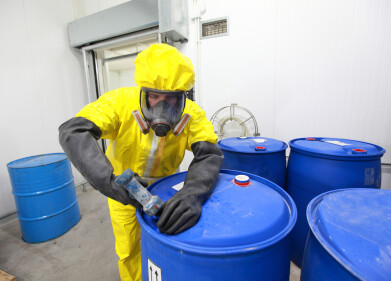Elemental analysis
What is Elemental Analysis? - A Guide to Fuel Analysis Methods
May 19 2021
Elemental analysis is a pillar of the oil and gas industry, helping to maintain everything from fuel performance and quality control to occupational health and safety. Elements are often present in extremely low concentrations, meaning instrumentation must be highly sensitive to collect accurate and reliable results.
So, what is elemental analysis exactly? The term describes the process used to profile a sample and measure the levels of elements it contains. Figures are usually recorded as a weight percent and offer scientists a detailed picture of the unique characteristics of a sample.
The process isn’t just used in the oil and gas sector, with elemental analysis also used to profile soils, drinking water, chemical products and even bodily fluids. Below, we take a look at some of the most common elemental analysis techniques used by laboratories to examine fuel. Each technique has its own pros and cons, meaning most laboratories rely on multiple analytical methods to ensure accurate results.
X-Ray Fluorescence (XRF)
As the name suggests, X-Ray Fluorescence (XRF) uses high-energy electromagnetic radiation to excite a material and measure the "secondary" X-Rays it emits. The non-destructive technique is an accurate and relatively straightforward way to analyse elemental composition, making it popular across the energy industry.
Every element emits a unique set of X-Rays when exposed to high-energy electromagnetic radiation, allowing scientists to create a set of “fingerprints” and map out the unique characteristics of a sample. In cases where many different elements are present a wavelength dispersive spectrometer can be used to separate the “fingerprints” and detect individual elements.
While there are some disadvantages to the technique, overall XRF is coveted for ease of sample preparation, the scope for rapid multi-element screening and its compatibility with a variety of sample types, including slurries, rocks and viscous liquids.
Measuring sulphur content is one of the key uses of XRF in the oil and gas industry, with the technique used to determine whether oil is sweet or sour. Ultraviolet Fluorescence is commonly used with light hydrocarbons, while Wavelength Dispersive X-Ray Fluorescence Spectrometry (WDXRF) is also popular when analysing petroleum fuels.
Absorption Atomic Spectroscopy (AAS)
Using characteristic wavelengths of electromagnetic radiation emitted by a light source, Absorption Atomic Spectroscopy (AAS) detects elements in both liquid and solid samples. Atoms absorb radiation wavelengths at different rates, which allows scientists to measure what elements are present and at what concentrations. Fast, efficient and relatively inexpensive, the technique is widely used across the oil and gas industry.
Atomic Emission Spectroscopy (AES)
Atomic Emission Spectroscopy (AES) is based on a similar concept, though instead of measuring absorption rates scientists analyse the intensity of light emitted by excited atoms. Other commonly used variations of AAS include Flame Atomic Absorption Spectrometry (FAAS) which can be used to detect more than 60 metals. Graphite Furnace Atomic Absorption Spectrometry (GFAAS) is another well-established technique. Great for use with extremely low sample volumes, GFAAS is ultra-sensitive and capable of measuring elements at parts per billion concentrations.
Inductively Coupled Plasma (ICP) Techniques
While there are a few variations on Inductively Coupled Plasma (ICP) Techniques, all rely on the use of an extreme heat source such as plasma. This electrically neutral blend of electrons and ions is heated to temperatures of around 10,000K which fast-tracks ionisation.
Optical Emission Spectroscopy (ICP-OES) is one of the most commonly used techniques and sees samples injected into the plasma where it’s vaporised. This process liberates any elements contained in the sample and releases them as free atoms or ions. These atoms and ions then become excited and emit photons, which are measured using Optical Emission Spectroscopy (ICP-OES). While most ICP-OES) instruments can only detect single wavelengths, sequential scanning techniques or a polychromator can be used to measure multiple wavelengths. ICP-OES has impressively low detection limits, making it ideal for scientists looking to measure in parts per million (ppm) to parts per billion (ppb).
Another popular ICP technique is Inductively Coupled Plasma Mass Spectrometry (ICP-MS), an effective method used to detect low concentrations of mentals in liquid samples. Scientists start by using inductively coupled plasma to ionise a sample and create small polyatomic and atomic ions. These are then detected by the ICP-MS instrument and used to measure elemental percentages. As well as accurately detecting low concentrations of metals, ICP-MS can identify different isotopes of the same element.
Why is elemental analysis so important?
The elemental characteristics of fuel can vary enormously, with elements such as sulphur and chlorine having a major impact on price, performance and refinery compatibility. Optimising catalyst performance is one of the main reasons the industry places such a heavy focus on elemental analysis. Elements such as nickel, iron, vanadium and phosphorus can poison catalysts and compromise efficiency. Regulating catalyst poisons can help to increase the uptime of the Fluid Catalytic Cracking (FCC) conversion process.
Vanadium compounds can result in severe damage to furnaces, while volatile organometallic compounds can contaminate distillate fractions and reduce their stability. When combusted, this can result in equipment malfunction and costly repairs.
Pricing is another important variable determined by elemental analysis. An in-depth overview of elemental content helps to determine the quality of crude and establish a price point. As well as ensuring gold-standard crudes meet expectations, elemental analysis is also used to identify less valuable “opportunity crudes” that are purchased by refiners at heavily discounted prices. This calibre of crude can often translate to healthy profits for a refinery, though it’s important to have a good understanding of elemental composition to maximise margins.
The role of ASTM International
When it comes to testing and quality control, ASTM International sets a benchmark for technical standards. The organisation develops and publishes best-practice test methods to measure a constellation of elements, including sulphur, nitrogen, nickel and iron.
“Crude oils are highly complex hydrocarbons also containing some organometallic compounds, inorganic sediment, and water. Nearly 600 individual hydrocarbons, over 200 separate sulphur compounds, and about 40 trace elements have been found in crude oils,” reads the ASTM website.
ASTM methods are designed to not only maintain industry standards but make the elemental analysis process as easy and efficient as possible. For example, when detecting S, V, Fe and Ni in crude oil the ASTM suggests the use of ICP-AES, as outlined in the ASTM D7691 Standard Test Method for Multielement Analysis of Crude Oils.
“Inductively coupled plasma-atomic emission spectrometry (ICP-AES) is a widely used technique in the oil industry. Its advantages over traditional atomic absorption spectrometry (AAS) include greater sensitivity, freedom from molecular interferences, wide dynamic range, and multi-element capability,” reads the ASTM website.
Measuring ethanol
As well as testing crude oils before and during the refining process, elemental analysis is also an important part of quality control at petrol stations. This ensures forecourts are not only delivering products as advertised, but also helps to maintain consumer confidence and reduce the risk of major quality control incidents. For example, when the UK reclasses “premium” petrol as E10 this summer there will be a noticeable upturn in ethanol testing. The strategy is designed to slash CO2 emissions in the UK and help the country improve air quality and meet climate change targets. British-owned assurance, inspection, product testing and certification company Intertek uses ASTM standards to test for ethanol, as well as detect impurities.
Elemental analysis for quality assurance
Regular testing is also an important part of protecting the best interests of motorists. The consequences of negligence materialised in 2007 when several petrol stations in South East England sold fuel contaminated with silicon. More than 10,000 motorists purchased the contaminated fuel, which damaged lambda sensors in the engine management systems and caused around £10 million worth of damage. Forecourts run by supermarket chain Morrisons encountered a similar issue earlier this year, with the company confirming contractors accidentally added a "contaminated product" to the station’s fuel supply. This caused several breakdowns, as well as major road disruptions and a temporary shutdown of the forecourt.
As explored above, the methods used to analyse fuel are complex and heavily reliant on advanced equipment and instruments. The newly developed Xplorer-V model analyser from Dutch-based company TE instruments sets a new standard for measuring total sulphur and nitrogen levels in hydrocarbon products with boiling points of between 25 and 520 °C. Company representative Sebastian Sanchez introduces the new model and highlights some of the key benefits, including the use of a UV-fluorescence detector, in ‘Total Sulphur and Total Nitrogen analysis – Horizontal versus Vertical furnace arrangement’
Digital Edition
PIN 26.1 Feb/Mar 2025
March 2025
Analytical Instrumentation - Elemental Analysis for Quality and Process Control at Refineries, for Lubricants and Wear Metals in Engine Oils - Synthetic Lubricants: New Developments - Scaling...
View all digital editions
Events
Apr 08 2025 Birmingham, UK
Apr 08 2025 Kielce, Poland
Apr 08 2025 Ravenna, Italy
Apr 08 2025 Southampton, UK
Apr 08 2025 London, UK



















